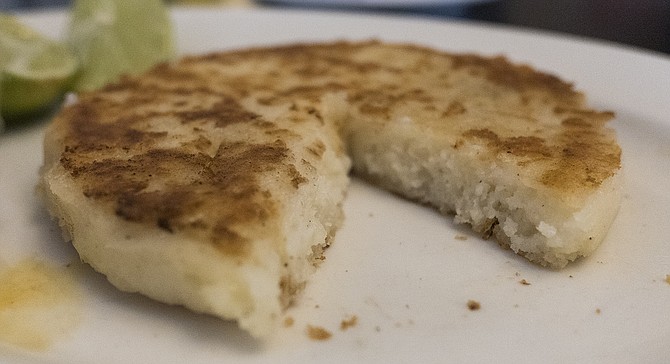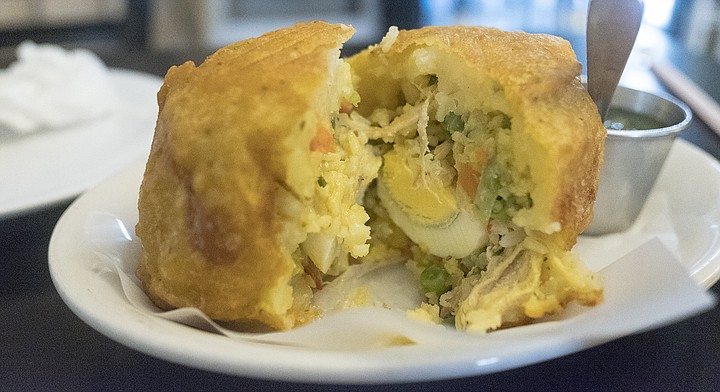 Facebook
Facebook
 X
X
 Instagram
Instagram
 TikTok
TikTok
 Youtube
Youtube

Nothing's likely to displace Mexican food as the object of my heart's — and belly's — affection. But I have been trying to learn more about a few of the other cuisines in our hemisphere by seeking out the small number of Caribbean and South American restaurants in town. This week, that meant going Colombian.
Specifically, Antojitos Colombianos, a little, casual sit-down restaurant on the border of Grant Hill and Logan Heights. Bright yellow walls match the top band of Colombia's tricolor flag, and imported South American snacks, cookies, and trinkets surround an open kitchen counter topped by an overhang of terra cotta shingles, a common architectural feature in the homeland of Gabriel García Márquez.

Antojitos Colombianos offers far more than antojitos, including a full complement of beef, chicken, pork, and fish plates served with rice and plantains. But given the restaurant's name, I wanted to focus on the "little cravings."
I'm familiar with the concept of antojitos from local Mexican bars, where the small plates commonly invite a comparison to Spanish tapas. In Mexican joints, antojitos feature different preparations of masa — the white corn (hominy) dough best known as the ingredient used to make corn tortillas and tamales.

As I quickly learned from reading this antojitos menu, these Colombian takes use corn meal and flour instead of masa. To make masa, ground corn goes through a process called nixtamalization, which breaks it down on a cellular level so that it can be formed into a dough. With cornmeal, on the other hand, you get ground yellow corn that we more often see used to make corn bread or polenta.
However, corn meal doesn't easily form dough on its own, so the variety of bready antojitos served here mix corn flour with milk, cheese, and eggs. It's kind of amazing how many different ways this can go — even the popular empanadas here are made with corn flour crust instead of wheat.
At $1.50 apiece, almojabanas are small pucks of cheesy bread. Not bread topped by melted cheese; more like infused by it. Like the salty white cheese and egg mixture replaces wheat gluten.
Another $1.50 take on this formula, the buñuelo, is a spherical, baseball size corn fritter. While the salty tang of cheese is evident, the fried bread comes off drier, like a giant hush puppy. By far, my favorite of these cornbready antojitos was the $2 arepa. This cheesy cornmeal pancake resembles a latke, and eats like a cheesy polenta cake.
However, my favorite option has to be the $4.50 papa rellena. As Feaster Kirk K. pointed out a few years back, the softball sized fried mashed potato ball has a crispy exterior, and saffron rice and chicken inside. There's no fixed filling however, and when I tried it, the chicken and rice included peas, chili peppers, and a hard boiled egg. It's like a tricked-out version of a smaller papa rellena I found made with seasoned ground beef at a Cuban eatery earlier this year.
I shouldn't be surprised. As fans of geography already know, Colombia has a Caribbean coast. It also has a Pacific coast, which makes me wonder what similarities I'll find when I visit the Salvadoran restaurant next door to Antojitos Colombianos.


Nothing's likely to displace Mexican food as the object of my heart's — and belly's — affection. But I have been trying to learn more about a few of the other cuisines in our hemisphere by seeking out the small number of Caribbean and South American restaurants in town. This week, that meant going Colombian.
Specifically, Antojitos Colombianos, a little, casual sit-down restaurant on the border of Grant Hill and Logan Heights. Bright yellow walls match the top band of Colombia's tricolor flag, and imported South American snacks, cookies, and trinkets surround an open kitchen counter topped by an overhang of terra cotta shingles, a common architectural feature in the homeland of Gabriel García Márquez.

Antojitos Colombianos offers far more than antojitos, including a full complement of beef, chicken, pork, and fish plates served with rice and plantains. But given the restaurant's name, I wanted to focus on the "little cravings."
I'm familiar with the concept of antojitos from local Mexican bars, where the small plates commonly invite a comparison to Spanish tapas. In Mexican joints, antojitos feature different preparations of masa — the white corn (hominy) dough best known as the ingredient used to make corn tortillas and tamales.

As I quickly learned from reading this antojitos menu, these Colombian takes use corn meal and flour instead of masa. To make masa, ground corn goes through a process called nixtamalization, which breaks it down on a cellular level so that it can be formed into a dough. With cornmeal, on the other hand, you get ground yellow corn that we more often see used to make corn bread or polenta.
However, corn meal doesn't easily form dough on its own, so the variety of bready antojitos served here mix corn flour with milk, cheese, and eggs. It's kind of amazing how many different ways this can go — even the popular empanadas here are made with corn flour crust instead of wheat.
At $1.50 apiece, almojabanas are small pucks of cheesy bread. Not bread topped by melted cheese; more like infused by it. Like the salty white cheese and egg mixture replaces wheat gluten.
Another $1.50 take on this formula, the buñuelo, is a spherical, baseball size corn fritter. While the salty tang of cheese is evident, the fried bread comes off drier, like a giant hush puppy. By far, my favorite of these cornbready antojitos was the $2 arepa. This cheesy cornmeal pancake resembles a latke, and eats like a cheesy polenta cake.
However, my favorite option has to be the $4.50 papa rellena. As Feaster Kirk K. pointed out a few years back, the softball sized fried mashed potato ball has a crispy exterior, and saffron rice and chicken inside. There's no fixed filling however, and when I tried it, the chicken and rice included peas, chili peppers, and a hard boiled egg. It's like a tricked-out version of a smaller papa rellena I found made with seasoned ground beef at a Cuban eatery earlier this year.
I shouldn't be surprised. As fans of geography already know, Colombia has a Caribbean coast. It also has a Pacific coast, which makes me wonder what similarities I'll find when I visit the Salvadoran restaurant next door to Antojitos Colombianos.
Comments